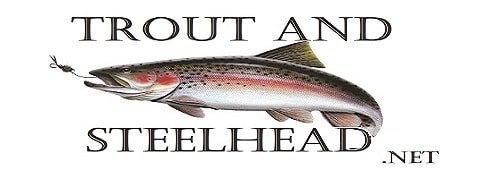Fly Fishing For Beginners: Fly Fishing Instructors Tell You How
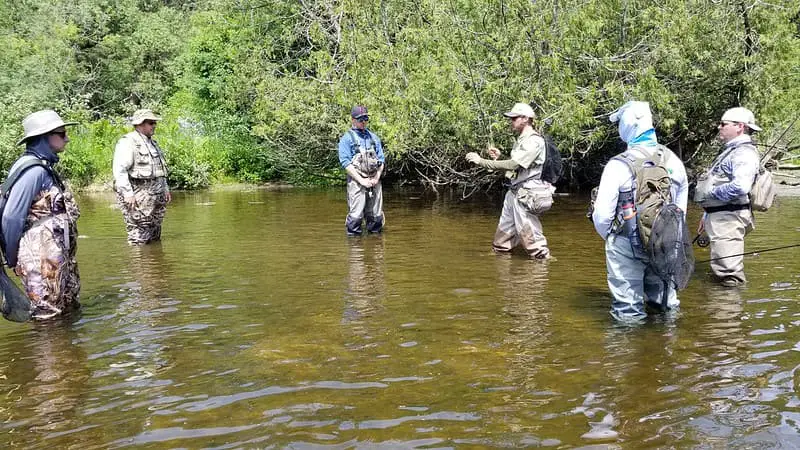
As a fishing guide and fly fishing instructor, I have taught thousands of anglers how to fly fish. I have done many one-on-one lessons and also done classes with up to 20 students.
As a new fly angler, learning from seasoned fly fishing instructors or a guide means you learn the right stuff and you learn the right way!
Fly fishing for beginners is all about knowing what to use and how to use it. That includes the right fly rods and reels, essential river gear, flies that work for each species, the best methods to use, how to cast a fly, and how to fish it all effectively.
There’s more! Actually, there’s a lot more that you need to know if you want to be successful early in your fly fishing adventure. I’m going to break it all down for you the same way that I do in my “beginner fly fishing” classes, and when I teach new fly anglers one-on-one.
What Is The Difference Between Fly Fishing And Regular Fishing?
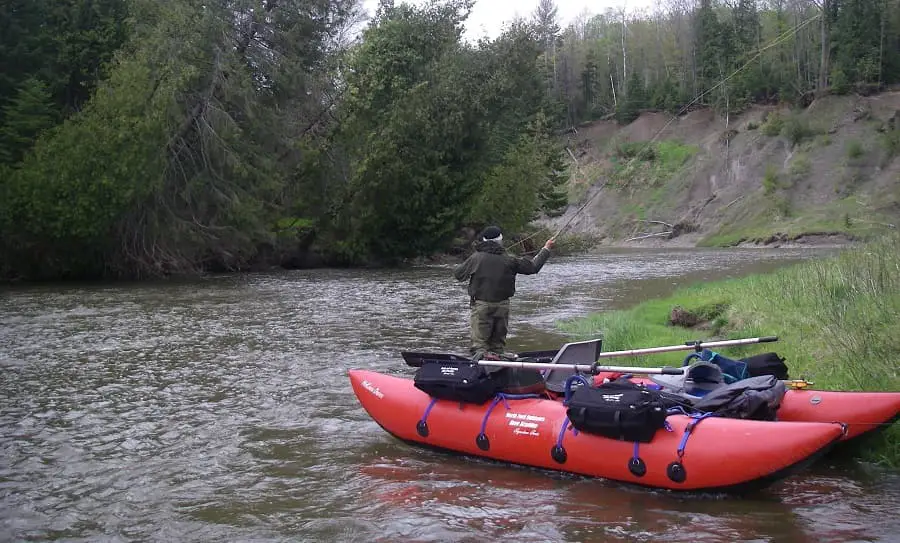
The simple answer is that with regular fishing, the weight of the lure or bait carries the line out to the fish, but since some flies are as small as a mosquito and are virtually weightless, you can’t cast them with a regular fishing line.
Therefore, when fly fishing, the weight of the fly line carries the small weightless flies out to the fish.
With nearly weightless flies, fly anglers have the ability to fish floating flies on the surface of the water, or submerged flies below the surface.
Is Fly Fishing Hard To Learn?
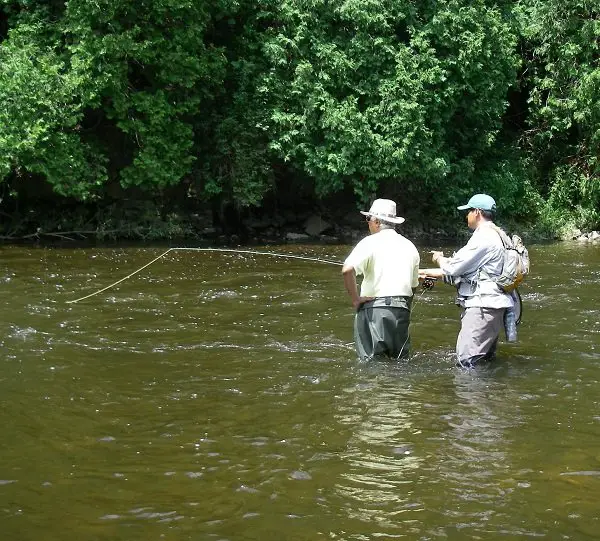
A common misconception is that fly fishing is hard to learn, and it can be for some anglers, but, it can also be easy if you know where to start and what to focus on.
The truth is, I have had clients that have never even touched a fly rod, catching trout in less than 5 minutes.
I’ve had young kids under 10 with almost zero fly fishing experience catch over 20 trout in 6 hours. You might be asking, how is this possible?
It’s simple: use one of the easier methods of fly fishing, start with fish that are easier to catch, and follow a step-by-step process.
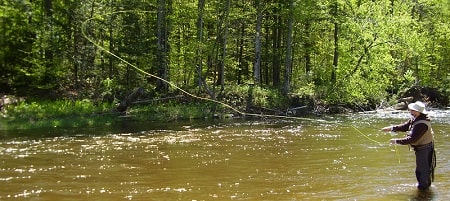
Some methods of fly fishing do not require you to fly cast the line. Fly casting well is probably the hardest part, but once you learn it, it is also very easy.
What makes fly fishing hard for beginners is not knowing the proper steps and methods to use, and then hitting the water and trying all kinds of stuff that just doesn’t work or you just don’t have the required skills.
How Much Does It Cost To Start Fly Fishing?
The short answer is that you could pay as little as $70 for a low-end complete fly fishing outfit, up to $400.00 for a midrange outfit, which could include waders and release tools, or it’s possible to spend over $3000.00 on all the best gear.
Learn more at: How Much Does It Cost To Start Fly Fishing And How To Save Some Money
Quick Beginners Guide To Fly Fishing
Before I get into the easy first steps, consider these tips from our guides to help you as a new fly angler.
- Use the right gear: It’s important to use the right gear for the species you want to fish for, and for the type of water you plan to fish.
- Be patient, and don’t expect too much at first: You will not catch a lot of fish at first unless you are standing beside a great guide. Therefore, with patience and practice, fly fishing will get much easier.
- Practice casting and your presentation: Every sport requires practice if you want to get good, and so does fly fishing. Casting practice will enable you to get your fly to the fish so it’s important for most fly fishing methods.
- Utilize fly shops: The local fly shop is a wealth of information on local fishing
- Local Guides: You do not always need to hire a guide to get tips from the guide. Often, you can find free advice and tips on local guide’s websites too.
- Awareness Of Surroundings: It is important to slow down and look around for clues about the fishing. This means the bugs and the water conditions.
- Be Quiet, and Learn To Position Yourself Properly: A simple tip to fly fish better that I provide to all my new fly fishing students is to position yourself in an area that enables you to get a great presentation but not let the fish see you or so you don’t spook the fish.
- Handle Fish Properly: Releasing fish ensures that the good fishing you are experiencing stays good. This means you need to learn to handle the fish properly so they swim away healthy.
Common Species To Fly Fish
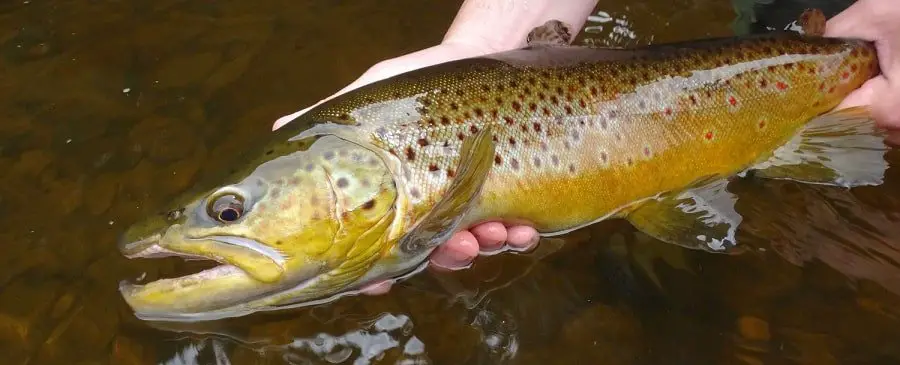
Even though you could fly fish for any species, I would not recommend learning to fly fish for a very difficult fish, or a very large fish at first.
Beginner fly fishermen should start fishing for more abundant and easier-to-catch fish like trout, panfish, and bass. These species are usually very abundant and the easiest to catch.
In most northern countries, especially in the USA and Canada, the most common species for fly fishing are trout, steelhead, salmon, and bass.
Essential Fly Fishing Gear List
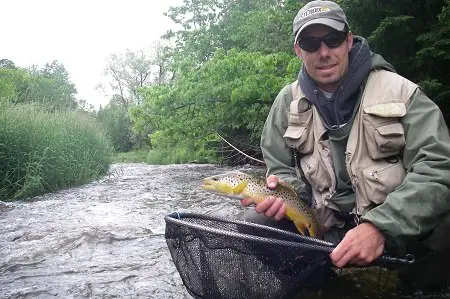
The five essential fly fishing items are:
- Fly rod and a fly reel filled with fly line
- A leader
- Tippet
- Flies
- Fly Box
Just those five things are all I would need to fly fish and catch fish.
Fly Rods For Beginners
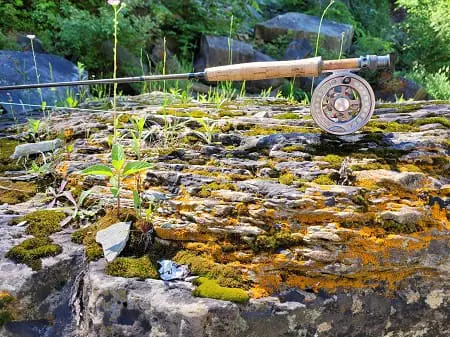
Fly rods come in lengths from 6 feet to 14 feet. However, the most common length for a fly rod is 8 to 9 feet long.
The best fly rod for beginners is an 8’6″ to 9-foot fly rod. This rod length is most popular for most methods and is relatively easy for beginners to cast.
Fly rods also come in weights ranging from 0 to 14. This is a weight rating system that helps anglers match up the rod to the size of the line, the size of the reel, the size of the fish, the size of the water, and/or even the size of the flies.
If you want more details on the best weight rod for trout, click HERE.
In order to get the perfect fly rod for you, you should determine:
- Type and size of fish you want to fish for
- Type and size of the water body you will be fishing
- Method or methods you will be using the most ( many rods can be used from multiple methods)
- Size of the flies required to catch the fish
My recommended general-purpose fly rod for beginners would be a 9 foot 5 weight rod. But, see the list below to know what best suites your needs)
- 1-3 Weight: best for Panfish, small trout, dry fly fishing, and small streams. ( best for dry fly and very light line nymphing)
- 4-5 Weight: good for small, medium to large trout, bass, and nymphing, small streamer fishing, ponds, small to mid-sized streams and rivers, ponds, and lakes. ( 4 weight is my go-to trout rod)
- 6 Weight: The most recommended rod size for multi-purpose fishing and for beginners. Good for medium-sized fish, good for bass, and great for medium to large rivers, lakes, and ponds.
- 7-8 Weight: steelhead, salmon, pike, bass, carp, large flies, bigger water, big rivers, and lake fishing.
- 9-10 Weight: large salmon, musky, and saltwater fish. Huge streamer flies and very large rivers, lakes, and ocean fishing.
- 10-14 Weight: This is a very big heavy fly rod that can be good for anything larger than salmon, such as Baracuda, Tarpon, and most saltwater fish.
You have many options for fly rods, You can also start with one of the fly rod and reel combos I recommend, or you can try my recommended fly rods for steelhead or for trout and for salmon.
Fly Reels For Beginners
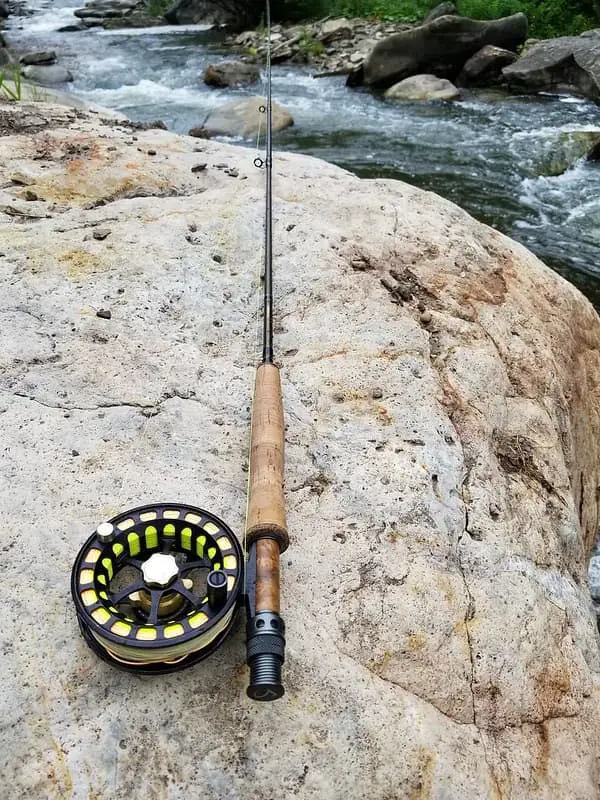
Fly reels are required to hold the fly line and to reel in the line when needed. They also aid in landing big fish.
Do not use a click-and-pawl reel unless you are advanced.
It’s important to match the reel to the rod size.
Fly Lines For Beginners
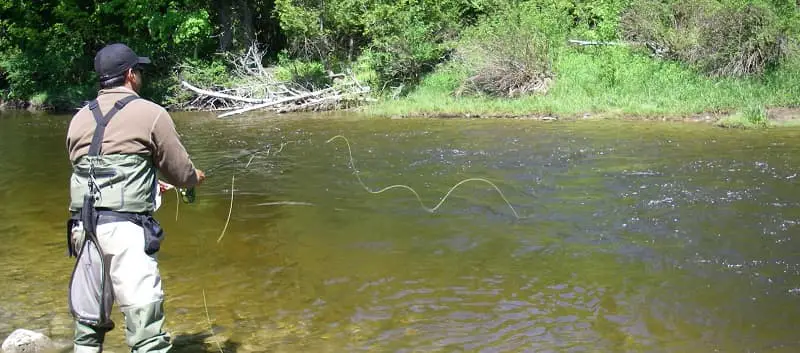
The fly line is thick and made of a strong inner core line, which is covered by a relatively soft, flexible, but durable plastic coating.
Fly lines use a rating system to match the fly line to the fly rod for the best casting performance.
There are different types of fly lines to consider. The most common fly line, and the one I recommend for new fly anglers is a weight forward floating fly line. Floating fly lines are easiest to cast and are good for both top-water and below-the-surface fly presentations.
Fly lines range from about $20 to over $100, but if you want to start fly fishing, most lines in the $40 to $80 range should be good enough.
Fly Line Backing
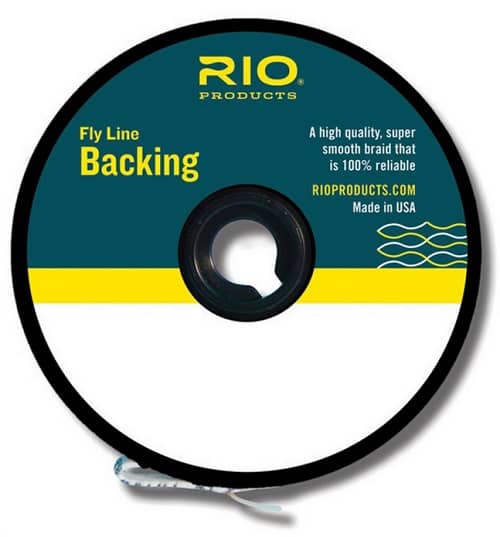
Because fly lines are so thick, they are made short, with an average fly line being 90 feet long.
Therefore, we add a thin but strong line called Fly Line Backing, which goes between the reel and the fly line. Backing not only adds another 300-plus feet of line but it also helps fill up the fly reel spool.
Leaders and Tippets
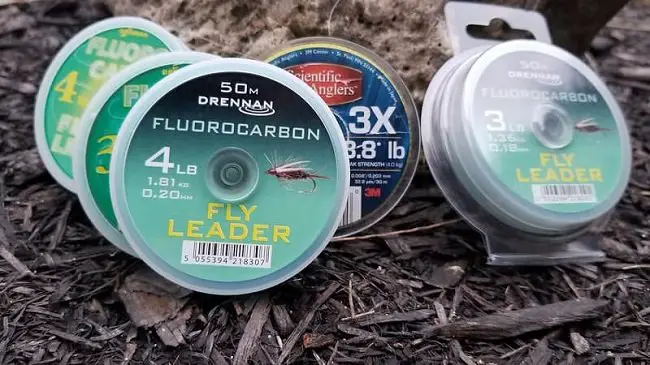
The fly line is thick and colorful, and therefore, we can’t tie it directly to the fly.
Instead, we add a tapered leader and often a short piece of line which is called a tippet line, which is where the fly is tied to.
The tapered leader is usually 7 to 9 feet of clear line that is thick at the top where it attaches to the thicker fly line and then tapers down to a thin section at the bottom where we attach the fly or a tippet line.
The thick upper section of the leader that attaches to the fly line aids in casting and helps straighten the leader out when the fly lands so the fly lands far enough away from the thick fly line.
We often add about 12 to 24 inches of a thinner non-tapered line called a tippet to the bottom of the leader.
Tippets come in small spools and it’s a good idea to have multiple spool sizes. Tippets can also greatly extend the life of your leader since you are cutting into your leader very little.
Check out What Pound Test Leader For Trout and What Pound Test Leader For Steelhead.
Flies
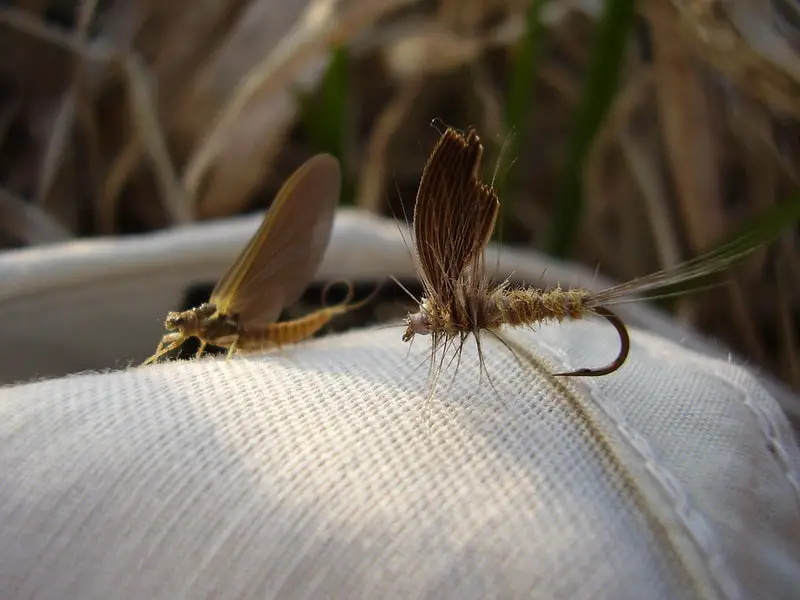
We use artificial lures called flies and we use them because they are light and we are able to cast them with the heavy fly line. Sometimes the flies are extremely small and less than 3/8 of an inch long.
Although they are called flies and are often thought to just imitate the small aquatic insects that live above or below the surface of the water, but artificial flies can also imitate fish, crayfish, leeches, frogs, and even mice, or pretty much any trout food source.
There are many different types of artificial flies for trout and for steelhead, and for salmon.
Dry Flies
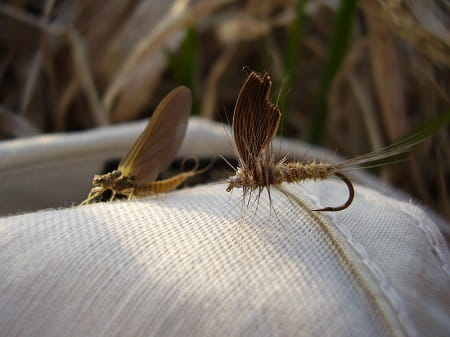
Dry flies float, and are meant to be fished on the surface. Dry flies can imitate aquatic insects such as Mayflies, Stoneflies, and Caddis, or even insects like beetles, ants, houseflies, bees, or grasshoppers.
Dry flies are designed to be used with the dry fly fishing method discussed below. For some of the most effective dry flies click the link.
Wet Flies
Wet flies are flies that are basically dry flies sunk just below the surface. They are designed to be used with the wet fly fishing method I will discuss below.
Nymphs
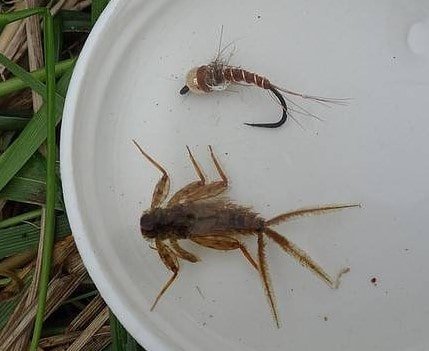
Below the surface live aquatic insects known as nymphs. Nymphes are often the young and immature stages of aquatic insects like mayflies, stoneflies, and caddis.
It is said that trout and other fish feed below the surface over 95 percent of the time so Nymph fishing is something I recommend new anglers start with.
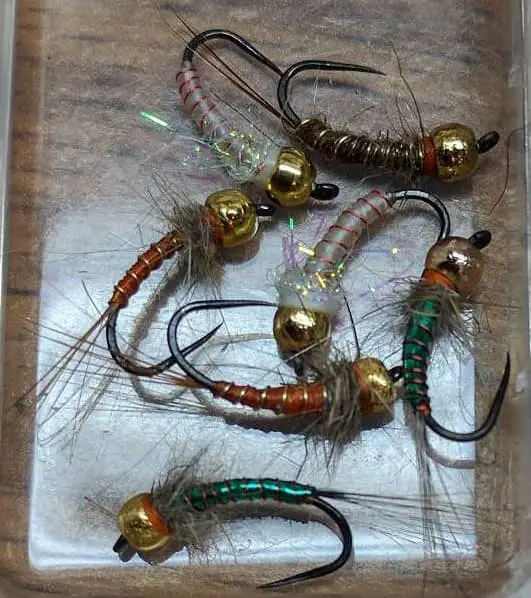
The good thing with nymph fishing is the cast distance is also usually short and you do not need to know the basic overhead cast.
Check out my page on Nymph Fishing.
Streamers
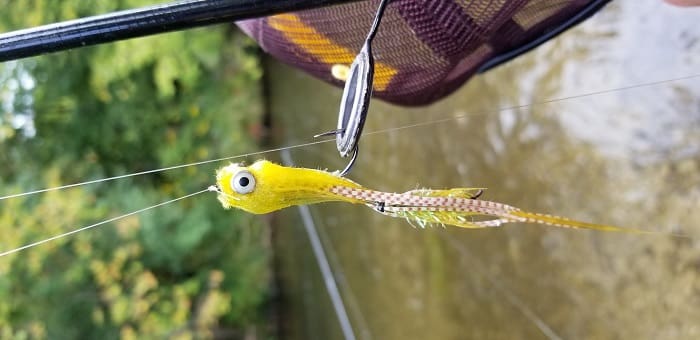
Streamers are often your biggest flies and are made to imitate minnows, leeches, crayfish, or other larger prey that swim.
Most streamer flies will be 2 to 4 inches long. Streamers are hard to cast so wait until you get proficient at casting before you try streamer fishing.
Non–Essential Fly Fishing Equipment
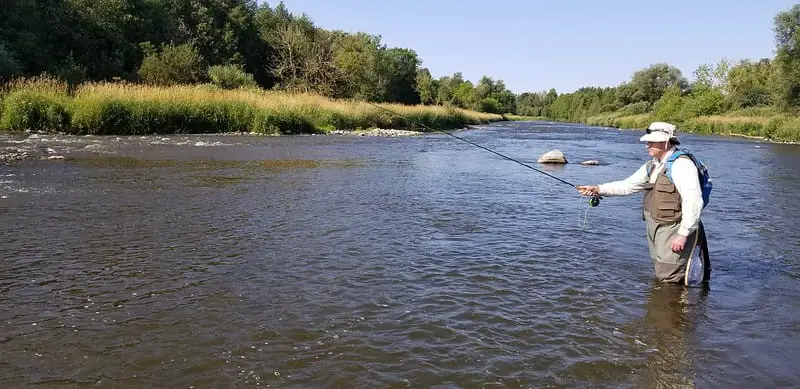
All you need to fly fishing is a rod, reel, fly line, leader, and a fly!
There are other things I could not do without on the river. These other things will just make your fly-fishing adventures so much better and much more effective.
Waders and Boots
Keep your legs warm, dry, and protected with waders and wading boots.
Waders keep your legs dry and comfortable, but they also protect your legs from cuts and scapes, as well as insects like mosquitos and ticks. Not to mention protecting you from poisonous plants like poison ivy.
Good wading boots will also offer more ankle support which is needed when walking the trails and rocky river bottoms.
There are two types of waders, Bootfoot, and Stocking Foot waders. These can be made from a few different types of materials.
Find out the waders and boots guides recommend to their clients and friends at:
- 7 Best Waders For Steelhead Fishing – Guides Advice
- 3 Best Waders For Winter Fishing: Guide Tested Waders
Wading Jacket
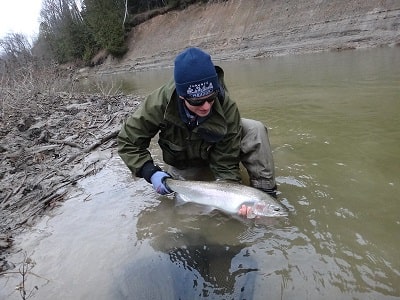
A good wading jacket is great for keeping the elements out, especially when the weather is colder or wet.
A good wading jacket will be wind-resistant and waterproof.
Just about all river guides will use a wading jacket when needed.
Wading jackets also tend to have plenty of pockets for your gear and are made short so you can wade deeper in the water without submerging your pockets.
Packs and Vests
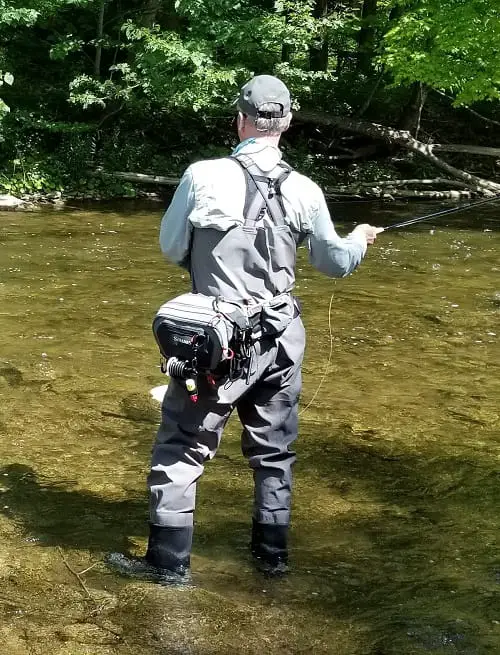
Fly fishermen and river anglers normally do not carry their stuff in tackle boxes.
Instead of a tackle box, or tackle bag, river anglers carry all their stuff in a fishing vest or a fishing pack so that all their stuff stays with them at all times.
Fly Boxes
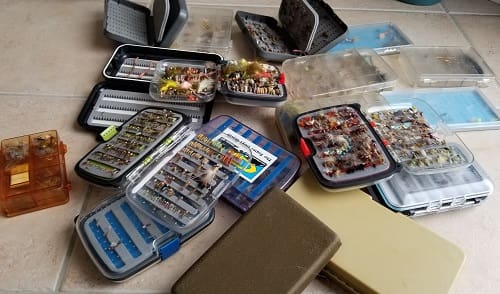
If you have flies then you will need to organize and store them in a fly box.
I prefer and recommend waterproof fly boxes and boxes that secure each fly separately.
Also, flies that are individually secured are easy to keep organized, and easier to grab, and should you drop an open box on the ground or in the water they won’t all fall out and cause you to spend an hour picking up 300 small flies.
Yes, I said 300 flies. Some fly boxes will hold a hundred flies, and some fly boxes will hold over 600 flies. See 12 Best Fly Boxes.
Landing Net
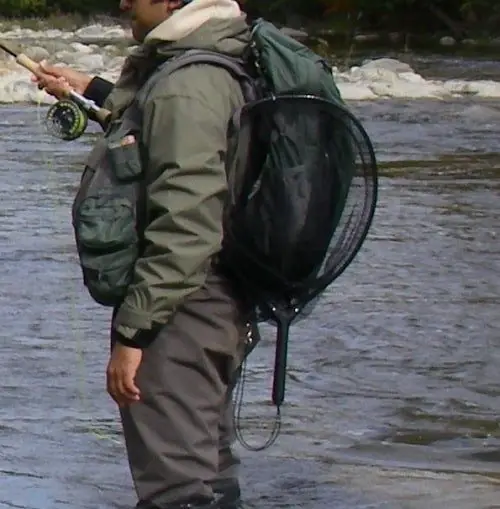
Honestly, although not an essential item, I can’t stress enough how important a landing net is to a fly fisherman.
If you want to land fish more consistently, or just want to be sure you land your first fish, get a decent net.
Check out Best Landing Nets For River Fishing.
Polarized Sunglasses
I could not do my job as a guide as well without a good pair of polarized glasses. Anglers and guides use them to protect their eyes, for reading water, and sometimes for spotting fish.
Polarized glasses cut the glare on the surface which also makes seeing flies and indicators much easier.
A good pair of Polarized glasses are an invaluable tool in my opinion.
Miscellaneous Fly Fishing Accessories
These are other items that come in handy when fly fishing. Some are almost must-have items.
Knippers:
Knippers or line cutters are used a lot when changing flies or adding tippet to leaders. A good pair of Knippers is an almost must-have. They are easier and faster than scissors.
Stream Thermometer
A stream thermometer is something just about every fly guide will have in their pack and so should you if you fish throughout the 3 or 4 seasons. Since trout, steelhead, and salmon are temperature sensitive it’s good to know if water temperatures are ideal for fishing or if you are just wasting your time.
Forceps: Aka Hemostats
Sometimes flies get deep in the mouths of the fish and the only way to get them out is with Forceps. Therefore I highly recommend a force suitable for the size of the fish you fish for. Thin long forceps are best for very small trout.
Fly Floatant
If you dry fly fish, fly floatant will be applied to your dry flies and will keep them from getting waterlogged, and it will keep them floating higher and longer.
Normally, I have found the higher your dry fly floats, the better it works. I use a combination of a fly floatant and a desiccant on my flies to dry them out and to keep them floating high. I tell you how I do this on my Best Fly Floatants page.
Weights For Fly Fishing
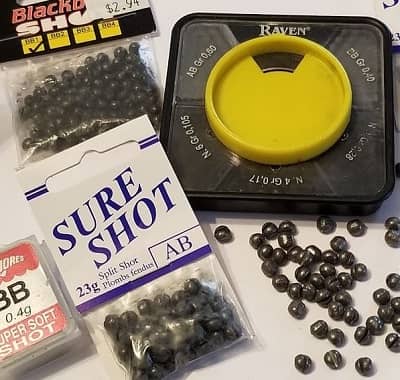
If you plan to nymph fish at all you will likely need weights called split shots. I use good quality dark or dull colored split shots a lot when I’m using subsurface flies.
I sometimes add a split shot just above small streamer flies to get them deeper.
Indicators
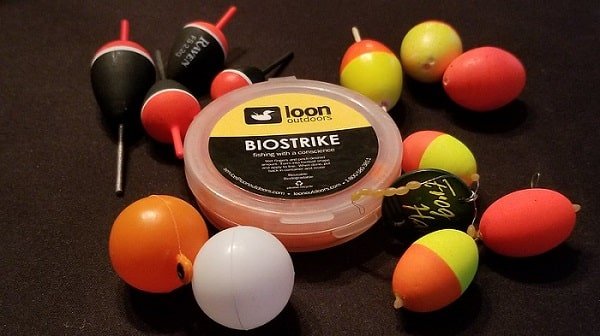
Indicators are like mini bobbers and are mostly used when nymph fishing for trout, steelhead, and salmon.
Indicators simply indicate when you have a bite, well, at least that’s what most guys think.
Fly Fishing Gear For Beginners.
That’s not all. There are other things you may eventually need, such as sun gloves, winter gloves, buffs, hats, sunshirts, hoodies, and even proper clothing to layer under your waders.
If you want to know more about all the fly fishing gear anglers and guides use and recommend, which includes all the stuff I mentioned above, check out Fly Fishing Gear: Everything You Need To Fly Fish
Fly Fishing Knots
There are a ton of knots that fly anglers could use, but when I’m teaching a new fly fisher, I keep it super simple and tell my students that they really only need to know two or three basic knots.
One knot is for tying the fly to the tippet or leader. For this, I recommend the Improved Clinch Knot, however, the double Davy Knot is the one that I use the most.
Or, the other knot which fly anglers use a lot to tie two pieces of line together, like when tying your tippet to your leader, is the Triple Surgeons Knot.
Basic Fly Casting
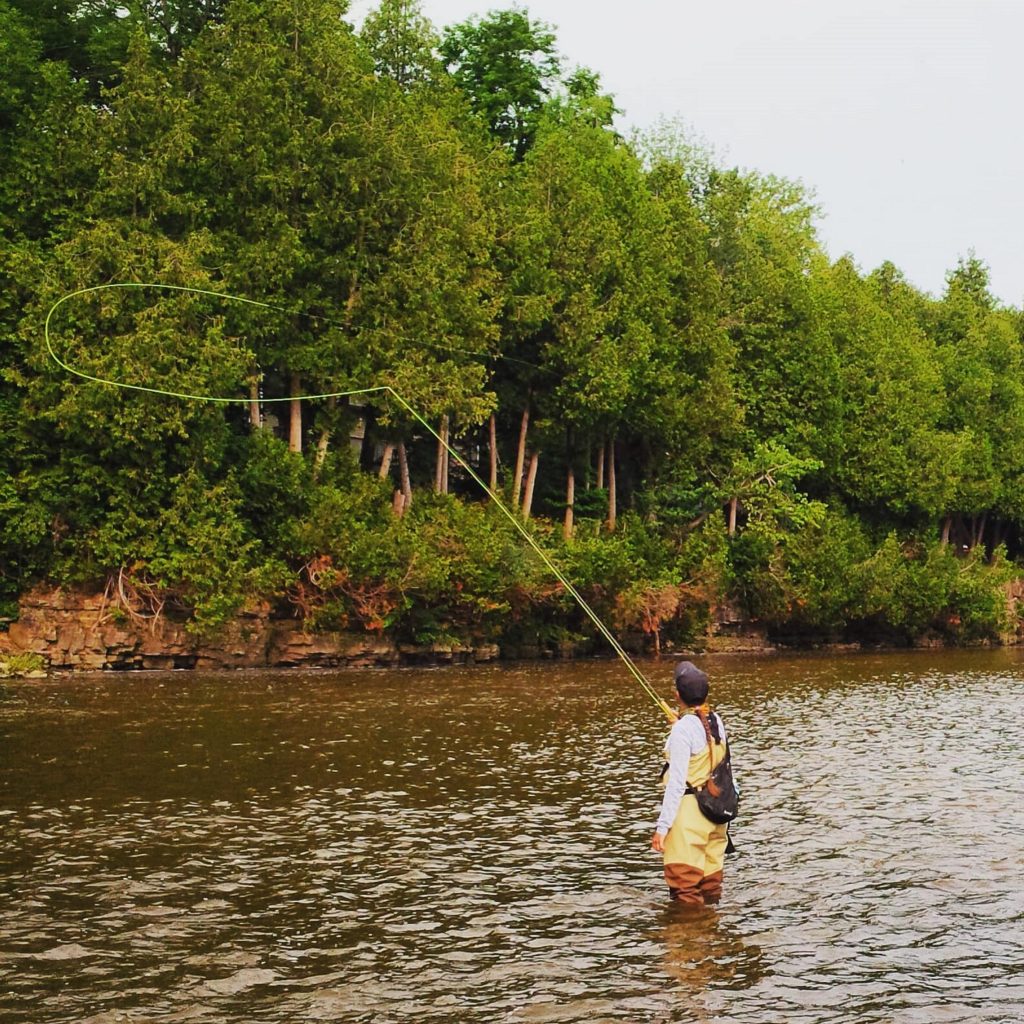
Fly casting can often be the most difficult thing in fly fishing, but once learned it’s actually very easy to do, and doing it well means catching fish more often.
The angler in the picture is a student of my good buddy Mike from Metcalfe School Of Fly Casting. Although not a requirement, having someone teach you to fly cast is a good idea.
There are two main fly casts for beginners: the roll cast and the overhead cast, which is shown in the above image. Both are required for catching fish depending on the conditions.
The overhead cast, also known as the standard fly cast or basic fly cast is the one you see most often.
With the overhead cast, you need almost as much space behind you as you want to cast forward. However, when you are limited backcast room anglers will use a roll cast.
The roll cast is much easier to learn and is normally only used when you can not do a back cast.
Fly Fishing Methods
There are multiple methods for dry fly fishing that new anglers might need to know. The method you use will depend on the fish and the conditions.
Dry Fly Fishing

Dry fly fishing is when you fish or float your fly on the surface of the water. Anglers use this method when trout or other fish are grabbing floating bugs off the surface.
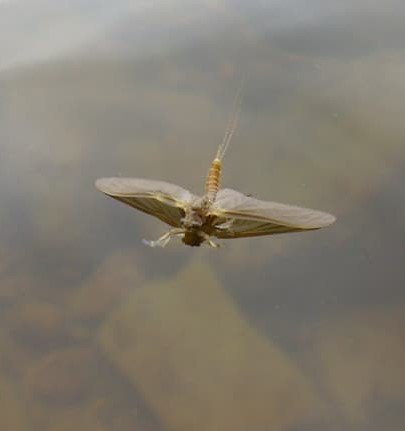
Common dry flies on many rivers are Caddis, Stoneflies, and Mayflies like the one in the picture.
Dry fly poppers can resemble frogs swimming on the surface, and these poppers can be great for bass, pike, or musky.
There are also situations where large dry flies are fished for saltwater fish.
Wet Fly fishing
Wet fly fishing is an old method where you cast across the river with a subsurface fly, and tighten the line and swing your fly across the river. This is an easy method for new fly anglers.
Nymphing
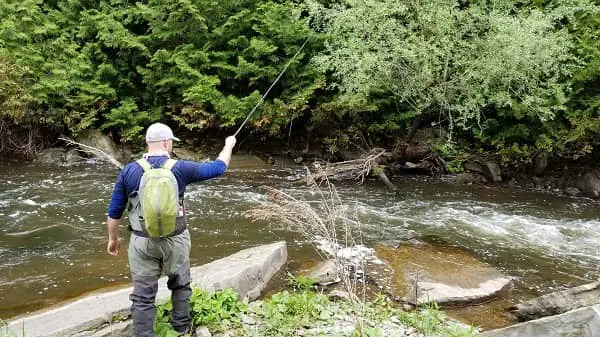
Nymphing is a way to imitate the dead drifting nymphs and aquatic insects and other food such as fish eggs that drift below the surface in rivers.
Nymphing is mostly done for trout, steelhead, and salmon, and at times, it can be the most effective method.
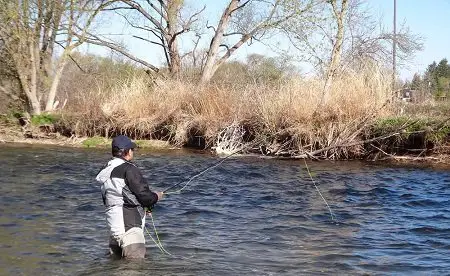
The three nymphing methods include indicator nymphing, high-sticking nymphing, or Euro Nymphing.
Indicator nymphing is probably the most widely used and is very effective for trout, steelhead, and salmon. I go into detail about this method on my page Indicator Nymphing: 13 Tips From Expert River Guides
Streamer Fishing
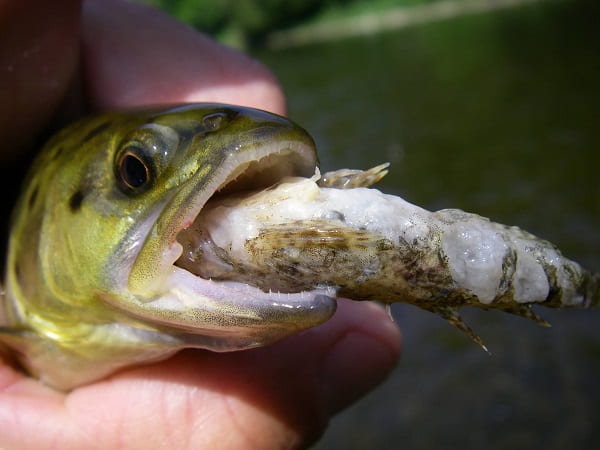
Most fish will eat other fish, whether that be small minnows or baitfish, or larger baitfish.
Even leeches, crawfish, frogs, and mice are all potential food for predatory fish.
We imitate these with flies called streamer flies and we use these streamers with a method known as streamer fishing.
Basic streamer fishing is simply casting out your streamer fly and then stripping it in.
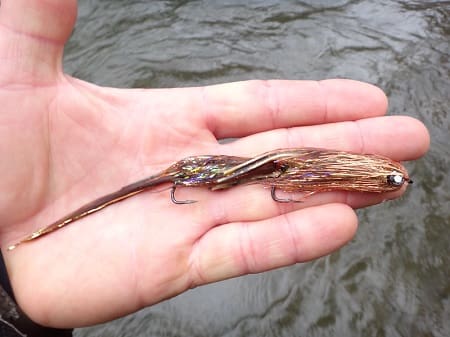
Stripping means pulling the fly line with you in short, fast, or abrupt pulls that cause the fly to twitch, jerk, and swim through the water.
Your goal is to imitate the swimming prey or an injured baitfish.
Spey Fishing
Spey fishing is a method normally using two-handed rods for steelhead and salmon. It is meant for super long casts with zero back casts and is generally used for steelhead and salmon, however, smaller Spey rods are now being made and used for trout on larger rivers.
Although a new angler can do this, I do not recommend it for new anglers.
The Hatch: Bugs For Trout
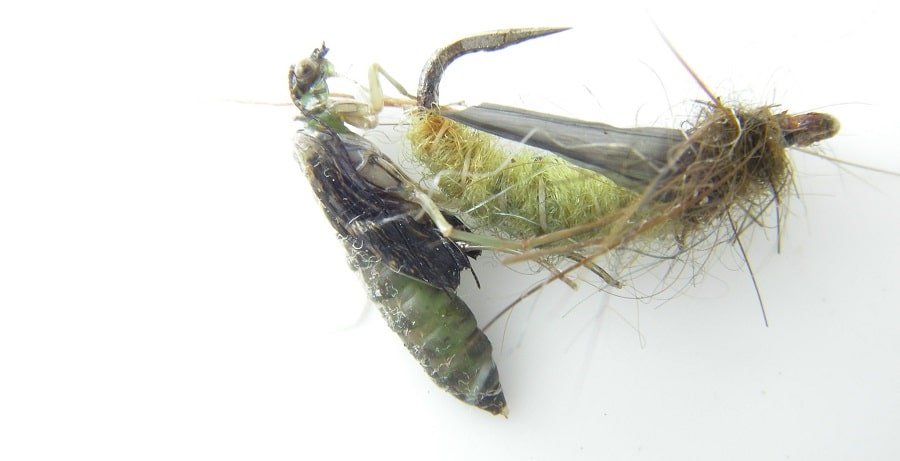
You may have heard or read something about a bug hatch, or matching the hatch.
A hatch is simply a time when many of the same species of aquatic insects become active or transition from nymphs to adult flying insects at once.
This insect activity can trigger feeding frenzies and is a great time to be on the water.
Fly Fishing Ponds and Lakes
Lakes and ponds can be great places to fly fish, and anglers will target bass, pike, musky, and trout in some lakes. At times, dry flies will work, but for the most part streamer fishing is how most anglers will fly fish a lake.
Fly Fishing Rivers And Streams
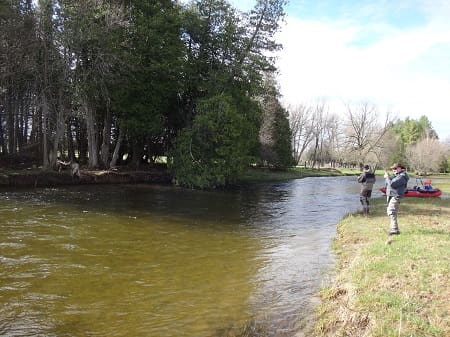
It’s hard to imagine a place better suited to fly fishing than fly fishing in rivers and streams.
There are just so many great fly fishing methods that work on rivers.
Rivers and streams are often the best spots for new fly anglers to learn fly fishing. Just find open water with not a lot of hanging trees and go have fun.
All rivers and streams can be fished with flies. The trick is finding out which ones have good fishing and finding good areas on these streams where you can access and legally fish.
Finding The Fish and Reading The Water: River Fishing
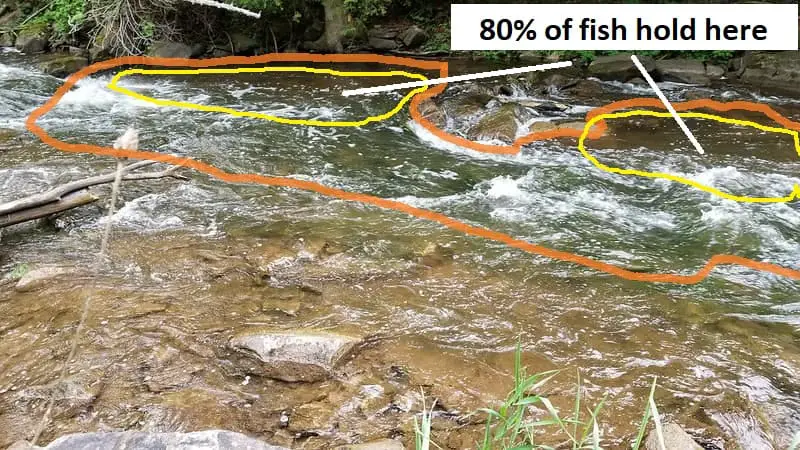
One thing I do well and different then the average angler is I see the water differently.
This is especially true in a lake where all you see is flat water.
But the truth is that guides and professional anglers visualize the structure. Structure often dictates where the fish will rest, hide, feed, and even swim.
In rivers, this is called reading the water and it’s much easier to do than in a lake.
Reading the water in a river usually means following the current and looking for deep sections, or structures such as rocks, logs, ledges, or holes that fish will hold near.
Fishing Rules and Fishing Regulations
Whether you want to fish in a lake or river, there are often official rules and regulations you must follow to fish lawfully.
This may also include having a valid fishing license or maybe even a trout or salmon tag.
For this reason, it is advised to check your local fishing regulations for your area to see what the rules and regulations are.
Fly Fishing Classes and Fly Fishing Lessons For Beginners
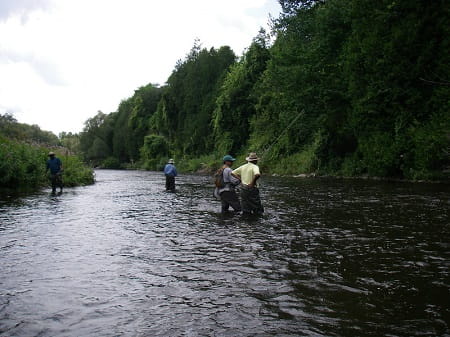
A fly fishing lesson can very quickly jump-start you in fly fishing and really shorten your learning curve.
A lesson is a great way to learn the basics and how to cast, and it shows you what you need to practice.
Hire Fishing Guides

I’ve been a fishing guide for 20 years and I have run many beginner fly fishing classes for up to 20 anglers a day. Honestly, I hate doing classes.
With a good guide, you will also learn the ins and outs and methods they use to catch fish constantly.
Fly Tying
Fly tying is not required for beginner fly fishing anglers. Even an experienced fly fisher does not need to learn to tie flies.
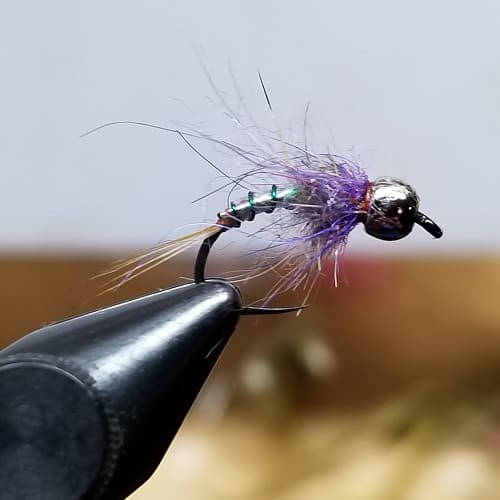
Flies can be purchased that to imitate the aquatic life of your local rivers.
An advantage of tying flies is you can really tie up some unusual-looking flies, design new patterns, and make flies that might be hard to find in the fly shops or online.
If you are getting into fly tying, Fly Tying Kits are a great way to get started. Some kits have all the materials you need, while others just have the vice and the tools.
My original article was very long so I created this article as a summary. If you are craving more information and more detail on fly fishing for beginners, see the full article on my page https://troutandsteelhead.net/beginner-fly-fishing-full-article/
Tight Lines,
Graham
